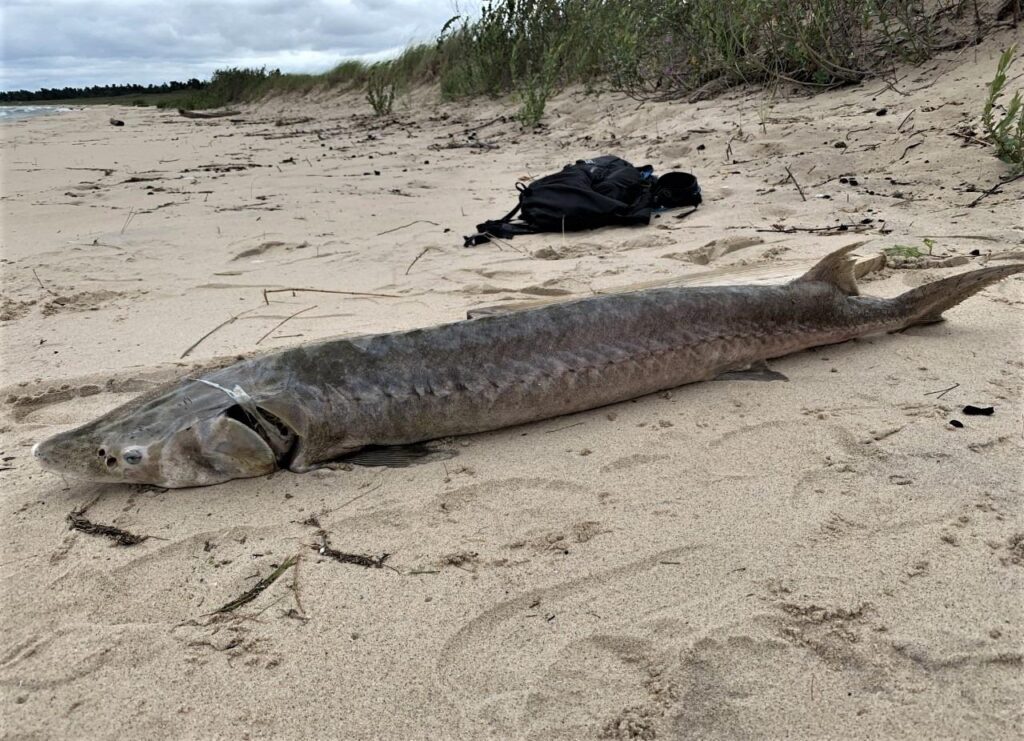“The sturgeon fish is swimming into our lives to prove we are stronger than we realize, and we may see the fruition of our intentions planted several months earlier, at the Aquarius New Moon back in February this year. The sturgeon is a tough fish that can live up to 140 years, offering hope we will make it through the remaining months of the year. The Sturgeon Moon should encourage those experiencing tough times in their lives and August’s Full Moon relates to survival.”
- Margarita Celeste, astrologer, on the “Sturgeon Moon”
On Aug. 3, Michigan experienced its full “Sturgeon Moon.” On Aug. 7, seven sturgeon washed up on the shore of Lake Michigan near Sleeping Bear Dunes. Cause of death is unknown, but avian botulism is believed to be the cause.
Lake sturgeon is a threatened species in Michigan and other Great Lakes states. In recent years, a resurgence in the population has been noted, particularly in spawning areas along the St. Clair-Detroit River corridor. Surgeon spawning reefs have been recreated off Belle Isle in the Detroit River, off Fort Malden in Amherstburg, Ontario, off McKee Park in Windsor, Ontario; off Fighting Island, in LaSalle, Ontario; and in the Trenton Channel, in Riverview, Michigan. The Fighting Island Sturgeon Spawning Reef is the first fish habitat restoration project in the Great Lakes funded by both the United States and Canada.
The sturgeon population, which has a lineage to the prehistoric period of North America, has been reduced by channelization of the spawning rivers, loss of coastal wetlands, filling shorelines for industrial and residential development, water pollution, removal of limestone bedrock that provided important spawning habitat for a multitude of native fishes and overfishing.
When mature surgeons die under mysterious circumstances, it drew the attention of U.S. and tribal environmental authorities. While avian botulism is a consideration, aquatic scientists need a living fish to conduct a test, according to a report by MLive https://www.mlive.com/public-interest/2020/08/botulism-suspected-in-sturgeon-deaths-at-sleeping-bear-dunes.html. This year, volunteers haven’t yet found a fresh enough carcass to test for the disease.
“I see them every year, but this year there has been quite a few,” noted Erica Plesha, U.S. National Parks staff based at Sleeping Bear Dunes. “It has not been a good few weeks for sturgeon.”
Olsen concurred. “There’s not much out there that will kill them,” he said, noting their resilience over centuries. “They are darn-near bulletproof. You can catch them, bring them back, tag them, keep them in a box of water while you get the information you need, let them go and they do just fine. … The only thing that would do it is type-E botulism, sadly.” (https://www.michiganseagrant.org/topics/coastal-hazards-and-safety/avian-botulism/).
With avian deaths, biologists suspect gulls and loons are eating baitfish that have been feeding in botulism hotspots around Sleeping Bear Dunes, such as Good Harbor Bay. University of Wisconsin-Madison researchers have videotaped invasive round gobies eating invertebrates amid mats of gooey green nuisance algae called cladophora, which grows in abundance offshore of Sleeping Bear. When the algae dies, it creates oxygen-depleted areas that are a perfect breeding ground for type-E botulism spores. The prevalence of invasive quagga and zebra mussels on the bottom are also seen as a contributing factor, as they filter nutrients from the water. The mussels create the clear water the area is known for, but the added sunlight helps fuel cladophora growth and provides the algae a place on the bottom to anchor.
While there are a handful of sturgeon reported dead on the beach each year, Olson speculates there could be many more in the lake that don’t wash ashore. “How many are on the bottom just rolling around that never make it to the beach?” he wondered, suggesting the suspected botulism deaths may be “the biggest source of mortality for sturgeon in the Great Lakes, or at least Lake Michigan.”
